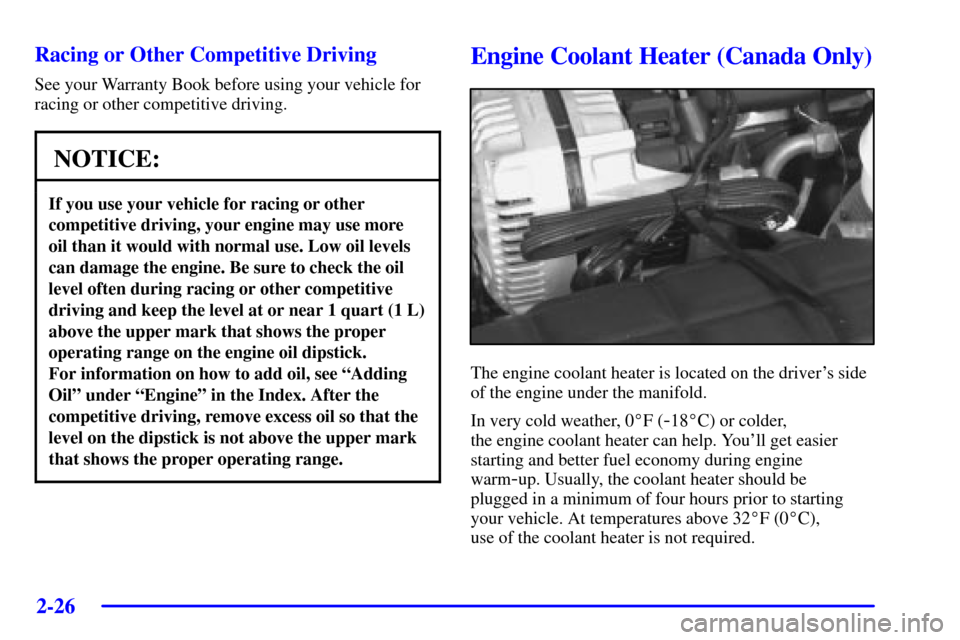Page 78 of 384

2-20
Disarming the System
Always use your key or the remote keyless entry
transmitter to unlock a door. Unlocking a door any
other way will set off the alarm. If your alarm sounds,
listed below are the ways you can disarm it:
�Unlock the driver's door with your key.
�Put the key in the ignition.
�Press the unlock button on the remote keyless
entry transmitter.
Now, if a door or the hatch/trunk lid is opened without
the key or the remote keyless entry transmitter, the
alarm will go off. Your horn will sound for two minutes,
then it will go off to save battery power. And, your
vehicle won't start.
The theft
-deterrent system won't arm if you lock the
driver's door with a key, the manual door lock, or if you
use the power door lock after the doors are closed.
If your passenger stays in the vehicle when you leave
with the keys, have the passenger lock the vehicle after
the doors are closed. This way the alarm won't arm,
and your passenger won't set it off.
PASS-Key�
Your vehicle is equipped
with the PASS
-Key
(Personalized Automotive
Security System)
theft
-deterrent system.
PASS
-Key is a passive
theft
-deterrent system.
It works when you insert
or remove the key from
the ignition.
PA S S
-Key uses a resistor pellet in the ignition key that
matches a decoder in your vehicle.
When the PASS
-Key system senses that someone is using
the wrong key, it shuts down the vehicle's starter and fuel
systems. For about three minutes, the starter won't work
and fuel won't go to the engine. If someone tries to start
your vehicle again or uses another key during this time,
the shutdown period will start over again. This discourages
someone from randomly trying different keys with different
resistor pellets in an attempt to make a match.
The key must be clean and dry before it's inserted in the
ignition or the engine may not start. If the SECURITY
light comes on, the key may be dirty or wet.
Page 84 of 384

2-26
Racing or Other Competitive Driving
See your Warranty Book before using your vehicle for
racing or other competitive driving.
NOTICE:
If you use your vehicle for racing or other
competitive driving, your engine may use more
oil than it would with normal use. Low oil levels
can damage the engine. Be sure to check the oil
level often during racing or other competitive
driving and keep the level at or near 1 quart (1 L)
above the upper mark that shows the proper
operating range on the engine oil dipstick.
For information on how to add oil, see ªAdding
Oilº under ªEngineº in the Index. After the
competitive driving, remove excess oil so that the
level on the dipstick is not above the upper mark
that shows the proper operating range.
Engine Coolant Heater (Canada Only)
The engine coolant heater is located on the driver's side
of the engine under the manifold.
In very cold weather, 0�F (
-18�C) or colder,
the engine coolant heater can help. You'll get easier
starting and better fuel economy during engine
warm
-up. Usually, the coolant heater should be
plugged in a minimum of four hours prior to starting
your vehicle. At temperatures above 32�F (0�C),
use of the coolant heater is not required.
Page 88 of 384

2-30
AUTOMATIC OVERDRIVE (�): This position is
for normal driving.
THIRD (3): This position is also used for normal
driving, however, it offers more power and lower fuel
economy than AUTOMATIC OVERDRIVE (�).
Here are some times you might choose THIRD (3)
instead of AUTOMATIC OVERDRIVE (�):
�When driving on hilly, winding roads.
�When going down a steep hill.
SECOND (2): This position gives you more power but
lower fuel economy. You can use SECOND (2) on hills.
It can help control your speed as you go down steep
mountain roads, but then you would also want to use
your brakes off and on.
If you manually select SECOND (2) when you start the
vehicle, the transmission will drive (and stay) in second
gear. You may use this feature for reducing torque to
the rear wheels when you are trying to start your vehicle
from a stop on slippery road surfaces, or for preventing
the transmission from downshifting into FIRST (1) in
situations where a downshift would be undesirable.FIRST (1): This position gives you even more power
(but lower fuel economy) than SECOND (2). You can
use it on very steep hills, or in deep snow or mud. If the
selector lever is put in FIRST (1), the transmission
won't shift into first gear until the vehicle is going
slowly enough.
NOTICE:
If your rear wheels can't rotate, don't try to drive.
This might happen if you were stuck in very deep
sand or mud or were up against a solid object.
You could damage your transmission.
Also, if you stop when going uphill, don't hold
your vehicle there with only the accelerator pedal.
This could overheat and damage the transmission.
Use your brakes or shift into PARK (P) to hold
your vehicle in position on a hill.
Maximum engine speed is limited to protect driveline
components from improper operation.
Page 90 of 384
2-32
Shift Speeds (Manual Transmission)
CAUTION:
If you skip a gear when you downshift, you could
lose control of your vehicle. You could injure
yourself or others. Don't shift down more than
one gear at a time when you downshift.
This chart shows when to shift to the next higher gear
for the best fuel economy.
If your engine speed drops below 900 rpm, or if the
engine is not running smoothly, you should downshift to
the next lower gear. You may have to downshift two or
more gears to keep the engine running smoothly or for
good engine performance.
NOTICE:
When you are shifting gears, don't move the
gearshift lever around needlessly. This can
damage parts of the transmission and may
require costly repair. Shift directly into the
next appropriate gear.
Page 91 of 384
2-33 One to Four Shift Light
(Manual Transmission)
When this light comes on,
you can only shift from
FIRST (1) to FOURTH (4)
instead of FIRST (1)
to SECOND (2).
You must complete the shift into FOURTH (4) to turn
off this feature. This helps you get the best possible
fuel economy.
After shifting to FOURTH (4), you may downshift
to a lower gear if you prefer.
NOTICE:
Do not try to force the shift lever into SECOND (2)
or THIRD (3) when the 1 TO 4 SHIFT light
comes on. Do not try to re
-engage FIRST (1)
after starting to shift into FOURTH (4). You will
damage your transmission. Shift only from
FIRST (1) to FOURTH (4) when the light
comes on.
This light will come on when:
�The engine coolant temperature is higher than
169�F (76�C),
�you are going 15 to 19 mph (24 to 31 km/h) and
�you are at 21 percent throttle or less.
Page 115 of 384
2-57
Storage Compartments
Glove Box
To open the glove box, lift up on the lever. Use your
door key to lock or unlock it. The glove box has a
light inside.
Instrument Panel Cupholder
The cupholder is located on the center console in front
of the ashtray. To open it, place your thumb on the left
side of the lid and push down. Raise the right side with
your index finger.
Center Console Storage
To use this storage area, pull up the lid on the driver's
side front edge of the console and swing it to the
passenger's side.
You can use the key to lock and unlock the console.
Don't leave the key in the lock, or it could be damaged
when the driver sits down.
The fuel filler door release button and accessory power
outlet are located inside the center console.
Page 135 of 384

2-77
The main components of your instrument panel are the following:
A. Instrument Panel Brightness Control
B. Head
-Up Display Controls (Option)
C. Turn Signal/Multifunction Lever
D. Driver Information Center (DIC)
(Located in the Instrument Cluster)
E. Instrument Panel Cluster
F. Windshield Wiper/Washer Lever
G. Driver Information Center (DIC) Buttons
H. Hazard Warning Flasher Button
I. Center Air Vents
J. Audio System
K. Comfort Controls
L. Fog Lamp Button (If Equipped)
M. Remote Hatch Release Button (Coupe) or
Remote Trunk Release Button (Convertible/Z06)
N. Ignition SwitchO. Shift Lever (Automatic Shown)
P. Traction Control System (TCS)
Button/Active Handling Button
Q. Accessory Power Outlet
(Located in the Center Console)
R. Selective Real Time Damping (Option)
S. Air Bag Off Light
T. Instrument Panel Cupholder
U. Remote Fuel Door Release Button
(Located in the Center Console)
V. Ashtray and Cigarette Lighter
W. Parking Brake
X. Glove Box
Y. Instrument Panel Fuse Block
(Located behind the Toe
-Board)
Z. Air Bag Off Switch (Located in Glove Box)
Page 136 of 384
2-78
Instrument Panel Cluster
Your instrument panel cluster and Driver Information Center (DIC) are designed to let you know at a glance how the
vehicle is running. You'll know how fast you're going, about how much fuel you have left and many other things
you'll need to know to drive safely and economically. The instrument panel cluster indicator warning lights, gages
and DIC messages are explained on the following pages.
United States shown, Canada similar